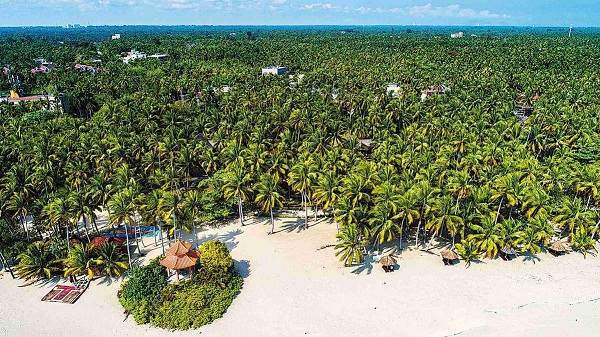
An aerial view of a coconut grove in Wenchang, Hainan province. [Photo provided to China Daily]
Hainan province plans to build a high-quality and competitive industrial chain for coconuts in the next five years to satisfy the rapidly expanding domestic market, according to a local government report.
The tropical island province, being the country's main producer, grows 232 million coconuts a year, 99 percent of China's total output yet only 0.42 percent of the world's production, which is far from meeting the country's needs.
Development of Hainan as an international tourism consumption destination, initiated by the central authorities in 2018, is expected to lead to a further uptick in demand. Trips by visitors are projected to reach 100 million annually by 2025, according to experts from Hainan's tourism departments.
They said that if a visitor consumes five fresh coconuts during each stay in Hainan, market demand would be about 500 million coconuts a year, while the annual demand in the Chinese mainland market is about 1 billion coconuts. The total demand would be 1.5 billion, or some 6.47 times China's existing production of coconuts. The gap becomes much greater if national processing needs are considered.
China's coconut imports make it the leader among 80 coconut importing countries. The nation accounts for about 16.3 percent of the global total, while the United States follows with 12.7 percent, according to the provincial government.
In its 14th Five-Year Plan (2021-25) for the High-Quality Development of the Coconut Industry, the province plans to expand the area planted with coconuts by 16,670 hectares through promoting new coconut tree varieties developed by Chinese scientists. The current area is about 34,526.7 hectares.
Wenye coconut tree, a new dwarf variety developed by experts in Wenchang in northeastern Hainan, produces about 43.35 percent of Hainan's coconuts, and plans call for it to be promoted as a high priority, the plan said. The trees, developed over two generations of scientists, make it much easier for farmers to pick the fruit, which are within reach, while the coconuts on other trees may be more than 10 meters above the ground, said Zhang Yufeng, an official at the Coconut Research Institute of the Chinese Academy of Tropical Agricultural Sciences.
"What is important and remarkable is that the dwarf coconut trees will help increase output. They bear fruit in three and a half years, four years earlier than the traditional tall varieties, and they are more productive, yielding 120 to 140 coconuts in their peak years under standard management, while a tall coconut tree bears only 60 to 80 on average," Zhang said.
Hainan will also encourage its enterprises to seek business agreements overseas to increase the supply of raw materials from coconuts, the plan said. It said China has a complete coconut processing industry, particularly in production of coconut juice, activated carbon, detergents, handicrafts and other products with highly standardized quality.
Also planned is encouragement of technical innovation in the coconut industry, further expansion of the industrial chain and development of more value-added products.
Hainan will explore coconut culture and develop tourism with coconut themes. The plan calls for a number of major projects, including an international coconut trading center, a coconut culture museum, coconut-themed tourist attractions and rural tourism demonstration sites.
By 2025, the total output value of the coconut-related industry in Hainan is projected to reach 23 billion yuan ($3.61 billion).